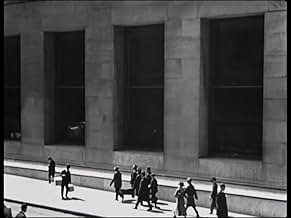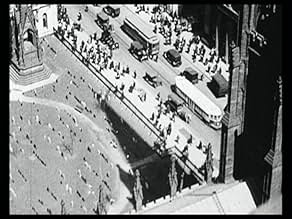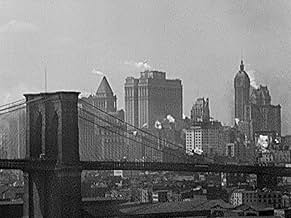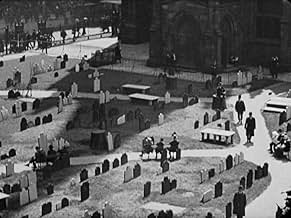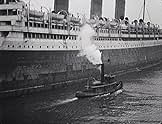AVALIAÇÃO DA IMDb
6,6/10
1,7 mil
SUA AVALIAÇÃO
Adicionar um enredo no seu idiomaThis groundbreaking silent documentary captures the beauty and majesty of the New York City in its streets, skyscrapers, bridges, rail yards and harbors.This groundbreaking silent documentary captures the beauty and majesty of the New York City in its streets, skyscrapers, bridges, rail yards and harbors.This groundbreaking silent documentary captures the beauty and majesty of the New York City in its streets, skyscrapers, bridges, rail yards and harbors.
- Direção
- Roteirista
- Prêmios
- 1 vitória no total
Avaliações em destaque
Preface: Due to the nature of such a short film, any valid review will contain some evidence of a "spoiler." This review is no exception.
Paul Strand's "Manhatta" is more than just the simple, pioneering piece in early cinema. "Manhatta" is a representation of New York City through the eyes of a still photographer. Strand uses the format of motion picture to create a sense of life. Similar to his New York still photography, each moving image frames city life, angles, and other objects with semi-avant-garde detail. Strand's own "mentor," Alfred Stieglitz, greatly appreciated the new form of city photography, publishing it in "Camera Work" and in his gallery 291.
In the movie, the blowing smoke, walking people, moving ships, and other objects in motion are what separate the motion picture from a photo album. Instead of portraying New York as an iconic, prosperous city, Strand has been able to portray New York City as an organism that contains a immigrant working class.
In my opinion, "Manhatta" commands the respect of many early motion pictures, influencing many great, more popular films.
Paul Strand's "Manhatta" is more than just the simple, pioneering piece in early cinema. "Manhatta" is a representation of New York City through the eyes of a still photographer. Strand uses the format of motion picture to create a sense of life. Similar to his New York still photography, each moving image frames city life, angles, and other objects with semi-avant-garde detail. Strand's own "mentor," Alfred Stieglitz, greatly appreciated the new form of city photography, publishing it in "Camera Work" and in his gallery 291.
In the movie, the blowing smoke, walking people, moving ships, and other objects in motion are what separate the motion picture from a photo album. Instead of portraying New York as an iconic, prosperous city, Strand has been able to portray New York City as an organism that contains a immigrant working class.
In my opinion, "Manhatta" commands the respect of many early motion pictures, influencing many great, more popular films.
This short film by Sheeler and Strand is the father of American avant-garde cinema.
It contains beautiful shots of Manhattan shown intertwined with excerpts of a Walt Whitman poem. All of the shots are thought out, and very photographic in nature. But that is expected with Paul Strand behind the camera.
This film is probably the first American avant-garde film, and if it isn't, it is definitely the first influential avant-garde film. A guideline for future American avant-garde filmmakers to follow.
A true visual treat, even for today's standard.
It contains beautiful shots of Manhattan shown intertwined with excerpts of a Walt Whitman poem. All of the shots are thought out, and very photographic in nature. But that is expected with Paul Strand behind the camera.
This film is probably the first American avant-garde film, and if it isn't, it is definitely the first influential avant-garde film. A guideline for future American avant-garde filmmakers to follow.
A true visual treat, even for today's standard.
Cinema had matured enough in the year 1921 to allow imaginative experimentation with celluloid. Two photographers combined Walt Whitman's lines of poetry with 65 filmed shots of New York City's Manhattan Island to produced their short movie 1921's "Manhatta." Some cite the pair's brief film as the first avant-garde work in moving pictures.
Charles Sheeler, a painter/photographer, and Paul Strand, photographer, decided to base their short project on passages from Whitman's 'Leaves of Grass.' They set their motion picture camera high above the city landscape, framing each of their 65 shots like they were using a still camera, dictating the artistry of the city's buildings and transport vehicles to determine its positioning. The camera rarely moves during each shot and sustains mostly wide shots of the city.
Not only does "Manhatta" serve as a fascinating historic photographic record of New York City over 100 years ago, it also reflects how humans apoear to be overwhelmed by the gigantic concrete structures and mammoth transports surrounding them. One particular visual exemplifying such magnitude is when a horde of workers crowd the stern of a ferry and unload in a rush to get where they need to go.
"Manhatta" was rarely shown after its completion, and when it did the movie was more of a curiosity. In 1950, a worn print of the short was discovered in a British film vault, and an archivist, beginning in 2005, spent four years to restore it to its current pristine form.
Charles Sheeler, a painter/photographer, and Paul Strand, photographer, decided to base their short project on passages from Whitman's 'Leaves of Grass.' They set their motion picture camera high above the city landscape, framing each of their 65 shots like they were using a still camera, dictating the artistry of the city's buildings and transport vehicles to determine its positioning. The camera rarely moves during each shot and sustains mostly wide shots of the city.
Not only does "Manhatta" serve as a fascinating historic photographic record of New York City over 100 years ago, it also reflects how humans apoear to be overwhelmed by the gigantic concrete structures and mammoth transports surrounding them. One particular visual exemplifying such magnitude is when a horde of workers crowd the stern of a ferry and unload in a rush to get where they need to go.
"Manhatta" was rarely shown after its completion, and when it did the movie was more of a curiosity. In 1950, a worn print of the short was discovered in a British film vault, and an archivist, beginning in 2005, spent four years to restore it to its current pristine form.
MANHATTA is an unusual short film. It's like the merging of a travelogue with a poem. So, as the camera moves artistically about the city of New York, the scenes are punctuated with intertitle cards that have poetic verse on them that make it all seem grand and majestic.
While much of this won't appeal to most viewers, the film is still worth seeing for two important reasons. First, the short is a wonderful historical record of the city. In other films of the era, New York is incidental, in a way. You might see bits and pieces of the city, but the city is not the star. Here, however, you see so much of the town that you wouldn't see otherwise--and much of it is gone today. Second, the film is very artistic in its cinematography--with wonderful aerial shots as well as nicely frames shots of the Brooklyn Bridge and the like.
Perhaps not exciting, but a rather important document. And, despite the original negatives being missing and only one print in existence until it was restored, the print looks great!
While much of this won't appeal to most viewers, the film is still worth seeing for two important reasons. First, the short is a wonderful historical record of the city. In other films of the era, New York is incidental, in a way. You might see bits and pieces of the city, but the city is not the star. Here, however, you see so much of the town that you wouldn't see otherwise--and much of it is gone today. Second, the film is very artistic in its cinematography--with wonderful aerial shots as well as nicely frames shots of the Brooklyn Bridge and the like.
Perhaps not exciting, but a rather important document. And, despite the original negatives being missing and only one print in existence until it was restored, the print looks great!
10DaveLB-3
Instead of having a filmmaker attempting to be painterly, this poetic gem boasts both a major painter (Sheeler) and a major photographer (Strand) collaborating.
This is the earliest view of Manhattan we have that is neither simple-minded documentation nor backdrop to melodrama. The visuals are striking, and stand up well to later, more gimmicky, film realizations of what makes Skyscraper National Park so special.
The Walt Whitman title cards would probably have worked better as voiceover narration in the sound era, but offer a strong romantic framework for the powerful imagery. A classic, not to be missed.
This is the earliest view of Manhattan we have that is neither simple-minded documentation nor backdrop to melodrama. The visuals are striking, and stand up well to later, more gimmicky, film realizations of what makes Skyscraper National Park so special.
The Walt Whitman title cards would probably have worked better as voiceover narration in the sound era, but offer a strong romantic framework for the powerful imagery. A classic, not to be missed.
Você sabia?
- CuriosidadesThe poet whose works are quoted during the film is Walt Whitman.
- Citações
Title Card - Walt Whitman: "City of the world - for all races are here, City of tall facades of marble and iron, Proud and passionate city."
- Versões alternativasThis film was published in Italy on an DVD anthology entitled "Avanguardia: Cinema sperimentale degli anni '20 e '30", distributed by DNA Srl. The film has been re-edited with the contribution of the film history scholar Riccardo Cusin . This version is also available in streaming on some platforms.
- ConexõesFeatured in The Secret Life of Sergei Eisenstein (1987)
Principais escolhas
Faça login para avaliar e ver a lista de recomendações personalizadas
Detalhes
- Tempo de duração
- 11 min
- Cor
- Mixagem de som
- Proporção
- 1.33 : 1
Contribua para esta página
Sugerir uma alteração ou adicionar conteúdo ausente

